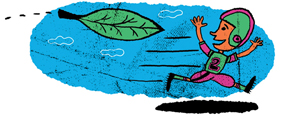sierraclub.org - sierra magazine - September/October 2009 - coolschools - environment 1, pollution 0


Cool Schools: The Third Annual List
 Say it's game day at your favorite Big 10 football stadium. Your home team is going strong, and the fans have come in droves; 90,000 of them have congregated, many traveling from hundreds of miles away. About 50,000 have driven, a third of those in SUVs. In sum, they've logged more than 6 million miles, burned through about 320,000 gallons of fuel, and booked some 4,000 hotel rooms. Factor in the energy used by the stadium, and that single game day could be pumping out 3,200 tons of carbon dioxide--the equivalent of what almost 300 homes, or close to 600 cars, use in an entire year.
Say it's game day at your favorite Big 10 football stadium. Your home team is going strong, and the fans have come in droves; 90,000 of them have congregated, many traveling from hundreds of miles away. About 50,000 have driven, a third of those in SUVs. In sum, they've logged more than 6 million miles, burned through about 320,000 gallons of fuel, and booked some 4,000 hotel rooms. Factor in the energy used by the stadium, and that single game day could be pumping out 3,200 tons of carbon dioxide--the equivalent of what almost 300 homes, or close to 600 cars, use in an entire year.
On that same game day, as the 90,000 barbecue in the parking lot or stock up on Styrofoam-shelled nachos at the concession stands, they produce about 45 tons of waste.
Now the good news: Many schools are working to limit the environmental impact of their athletics program. The University of Florida, for instance, has partnered with the nonprofit Earth Givers (earthgivers.org) to create the Neutral Gator initiative in an attempt to counter its game-goers' emissions. The effort includes lightbulb exchanges and reforestation operations throughout the community.
But mostly, says Dedee DeLongpre-Johnston, who directs the school's sustainability office, it's about using sports to educate fans. In that vein, Neutral Gator has set up booths outside the stadium where fans can learn about their game-day footprint and contribute to energy-efficient programs. "If people can come to our games and see what we are doing and take that back home and feel proud about it, then that's a win for me," DeLongpre-Johnston says.
The University of Colorado at Boulder has established a zero-waste program at Folsom Stadium. Vendors dispense only biodegradable utensils, containers, and wrappers, and fans dispose of their waste in recycling or composting receptacles. So far the school has reduced game-day trash by 80 percent.
Unfortunately, many schools are still fumbling.
A recent study found that only 10 percent of Division I sports departments are moving toward sustainability, even at colleges that have publicly pledged to reduce their carbon output. Until sponsors, alumni, and athletes start demanding more environmentally friendly facilities, a strong sustainability department appears to be a university's best shot at having a green sports program.
Educating athletes is key, says Alex Kayn Cousins, a University of Colorado soccer player who graduated this year with a degree in environmental science.
"If we start pushing this, maybe other people will pick it up and run with it."—Kathleen Nye Flynn
Illustration by Nate Williams